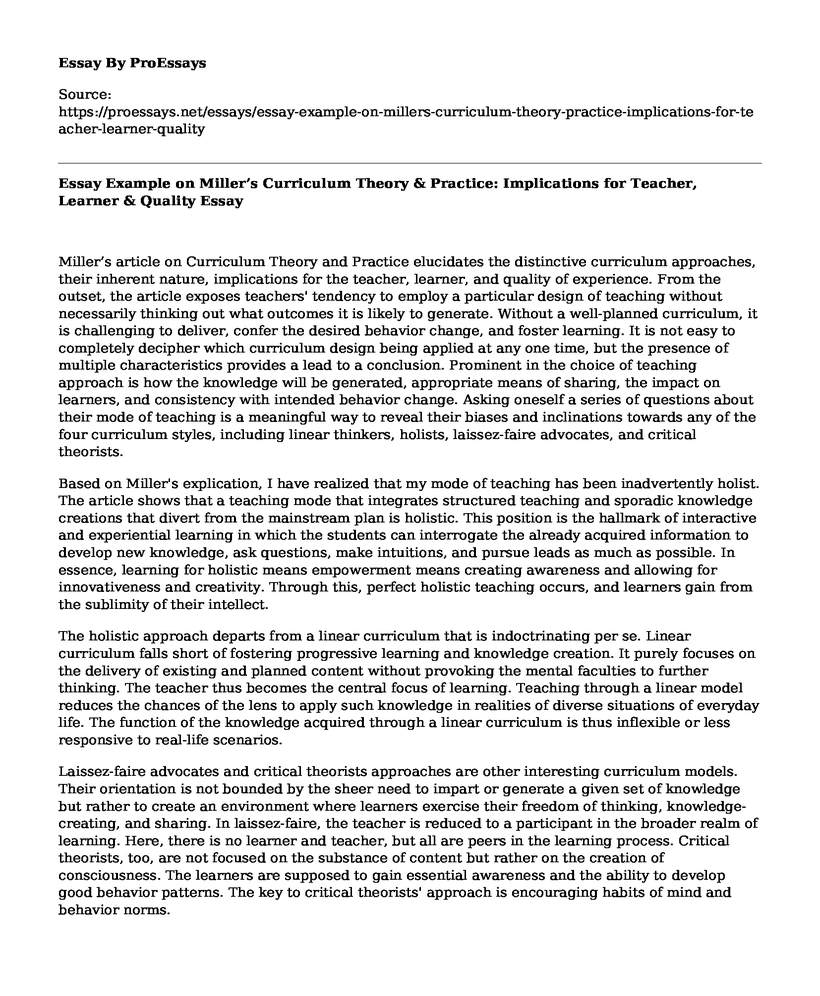Miller’s article on Curriculum Theory and Practice elucidates the distinctive curriculum approaches, their inherent nature, implications for the teacher, learner, and quality of experience. From the outset, the article exposes teachers' tendency to employ a particular design of teaching without necessarily thinking out what outcomes it is likely to generate. Without a well-planned curriculum, it is challenging to deliver, confer the desired behavior change, and foster learning. It is not easy to completely decipher which curriculum design being applied at any one time, but the presence of multiple characteristics provides a lead to a conclusion. Prominent in the choice of teaching approach is how the knowledge will be generated, appropriate means of sharing, the impact on learners, and consistency with intended behavior change. Asking oneself a series of questions about their mode of teaching is a meaningful way to reveal their biases and inclinations towards any of the four curriculum styles, including linear thinkers, holists, laissez-faire advocates, and critical theorists.
Based on Miller's explication, I have realized that my mode of teaching has been inadvertently holist. The article shows that a teaching mode that integrates structured teaching and sporadic knowledge creations that divert from the mainstream plan is holistic. This position is the hallmark of interactive and experiential learning in which the students can interrogate the already acquired information to develop new knowledge, ask questions, make intuitions, and pursue leads as much as possible. In essence, learning for holistic means empowerment means creating awareness and allowing for innovativeness and creativity. Through this, perfect holistic teaching occurs, and learners gain from the sublimity of their intellect.
The holistic approach departs from a linear curriculum that is indoctrinating per se. Linear curriculum falls short of fostering progressive learning and knowledge creation. It purely focuses on the delivery of existing and planned content without provoking the mental faculties to further thinking. The teacher thus becomes the central focus of learning. Teaching through a linear model reduces the chances of the lens to apply such knowledge in realities of diverse situations of everyday life. The function of the knowledge acquired through a linear curriculum is thus inflexible or less responsive to real-life scenarios.
Laissez-faire advocates and critical theorists approaches are other interesting curriculum models. Their orientation is not bounded by the sheer need to impart or generate a given set of knowledge but rather to create an environment where learners exercise their freedom of thinking, knowledge-creating, and sharing. In laissez-faire, the teacher is reduced to a participant in the broader realm of learning. Here, there is no learner and teacher, but all are peers in the learning process. Critical theorists, too, are not focused on the substance of content but rather on the creation of consciousness. The learners are supposed to gain essential awareness and the ability to develop good behavior patterns. The key to critical theorists' approach is encouraging habits of mind and behavior norms.
Conclusion
The article's exposition is significant in creating a hybrid teaching model that is likely to generate optimum outcomes. I will be able to come up with a teaching model which takes into account the desired goals, specific needs of learners, impact and implications on quality of knowledge generated, integration of learner creativity and sustained positive influence of their behavior. My holistic teaching style will enable me to provoke students into high-order thinking, following through disparate chains of thoughts and helping resolve dynamic learning problems. I will entirely involve the students in building knowledge around concepts and ideas introduced at any one time. This then can be flexible in applying principles, thoughts, and ideas as well as remaining active at all times.
References
Miller, D. L. (2011). Curriculum Theory and Practice: What's Your Style?. Phi Delta Kappan, 92(7), 32-39.
Cite this page
Essay Example on Miller's Curriculum Theory & Practice: Implications for Teacher, Learner & Quality. (2023, Aug 29). Retrieved from https://proessays.net/essays/essay-example-on-millers-curriculum-theory-practice-implications-for-teacher-learner-quality
If you are the original author of this essay and no longer wish to have it published on the ProEssays website, please click below to request its removal:
- Building Early Literacy Skills in Pre-School Children Essay
- Lifeline Project Paper Example
- Family Therapy: The Parent-Child Relationship and the Development of Secure Attachment in Young Children
- Mr. Bentley's Surprise Arrival: Shaking Up Our School - Essay Sample
- From West Africa to the US: Essay Sample on A Self-Analysis Journey of Life
- Essay on Survey of Student Accommodation, Travel Time & Exercise Habits
- Students w/ LDs at College: Challenges & Accessing Education - Essay Sample







